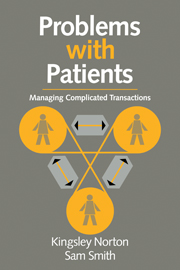Book contents
- Frontmatter
- Contents
- Foreword by Professor Paul Freeling, O.B.E.
- Preface
- Acknowledgments
- 1 Doctor–patient interaction
- 2 The clinical transaction
- 3 Interpersonal influences
- 4 The influence of past relationships
- 5 Contextual influences
- 6 Managing complicated clinical transactions
- 7 Interventions in complicated clinical transactions
- 8 Implications for the clinical setting
- 9 Implications for training
- Appendix I Clinical phenomena related to ‘problem patients’
- Appendix II Personality disorder
- References
- Index
8 - Implications for the clinical setting
Published online by Cambridge University Press: 19 March 2010
- Frontmatter
- Contents
- Foreword by Professor Paul Freeling, O.B.E.
- Preface
- Acknowledgments
- 1 Doctor–patient interaction
- 2 The clinical transaction
- 3 Interpersonal influences
- 4 The influence of past relationships
- 5 Contextual influences
- 6 Managing complicated clinical transactions
- 7 Interventions in complicated clinical transactions
- 8 Implications for the clinical setting
- 9 Implications for training
- Appendix I Clinical phenomena related to ‘problem patients’
- Appendix II Personality disorder
- References
- Index
Summary
Introduction
Potentially, the doctor–patient interaction, being an open system, is crucially affected by its immediate physical, emotional and social environment. In this chapter, aspects of the structure and organisation of the wider clinical setting are examined, as they may influence the clinical transaction so as to increase the risk of complication. Certain features of clinics are shared by both primary care and hospital-based out-patient settings. However, issues of size and scale are important and not all the aspects considered apply equally to each setting. Clinical transactions, especially complicated ones, influence the function of the supra-system of the clinic. Thus, the relationship between clinical transaction and the wider clinical context is interactive. Ways in which this interaction can be manifest are examined. Organisational structures that can reduce the potential for complicated transactions are described.
The physical setting
The physical setting of clinics forms part of the ‘frame’ in which the clinical transaction unfolds and should be acknowledged as being part of the therapist's communication with the patient (Langs, 1978). The setting not only communicates something attributable to the particular doctors who work there but it also conveys something about the system of health care as a whole, of which the clinic is only a part or subsystem. This potentially powerful form of non-verbal communication therefore makes its statement and has its effect at both public and personal levels.
The physical aspects of a clinical setting include the buildings and their location, the external and internal decoration, and the arrangements for reception, waiting areas, consulting and treatment rooms.
- Type
- Chapter
- Information
- Problems with PatientsManaging Complicated Transactions, pp. 128 - 143Publisher: Cambridge University PressPrint publication year: 1994



